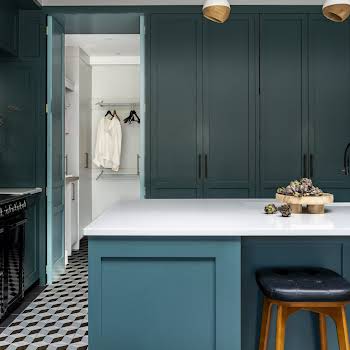
Here’s what you need to know to avoid a hellish (and budget-busting) home renovation
After undergoing her own home overhaul, interior designer and architect Denise O’Connor tells us her ultimate guide to home renovation.
It’s easy to get swept up in the excitement of a new kitchen or additional bedroom, choosing tiles and bed frames before you even have an inkling of layout. And, once it does get underway, you can be swept away by it, with no concept of how much things should cost or what to prioritise, just ready to get the builders out and have your own home again.
Architect and interior designer Denise O’Connor of Optimise Design knows the feeling. Having recently just renovated her own home, she was surprised by the challenges she faced as a homeowner, despite all the knowledge she had to her advantage.
 Denise O’Connor of Optimise Design
Denise O’Connor of Optimise Design
The experience gave her the idea for an event where she could share her learnings, both as a professional and as a client, with others going through the same stress. Curating a series of talks entitled Kickstart Your Home Improvement with Optimise Home, the first talk takes place on March 27 in The Dean Hotel and will bring in the expertise of surveyors, property experts, contractors and a neuroscientist for an all-around look at staying sane (and in budget) during a build.
Here, Denise gives us the run-down of what not to do, from scrimping in all the wrong places to skipping the important steps.
Putting the cart before the horse
Whether it’s a small bathroom renovation or a complete house refurbishment, there is a sequence of steps to follow to ensure everything goes to plan. It might be tempting to rush out and start buying tiles because they’re on sale or a sofa that you’ve had your eye on for a while, but you should wait until your layouts are finalised and you’re completely sure about what you’re doing, otherwise you could find yourself trying to work your design around something you wish you hadn’t bought in the first place.
Not planning for the future
It’s easy to design a home to suit your immediate needs but it’s important to future-proof too. Open-plan might sound ideal when you have small children, but as they grow into teenagers they’ll want space for themselves, and so will you. Having a separate den or sitting area is a good idea for families. Similarly, it’s not uncommon for couples renovating in their 40s to plan a ground-floor space that could be adapted to a bedroom.
Designing around something for the wrong reasons
Just because something has always been there doesn’t mean you need to keep it. Look at what you are trying to achieve and plan the best way to get there. This is where hiring a professional can be a good idea as they will have an impartial view of your home and be able to advise how best to achieve the results you want.

A kitchen extension by Optimise Design. Photo: Ruth Maria Murphy
Avoiding the budget
Prepare a thorough budget before you start work and be open about it with your architect, designer or contractor. They will help you to modify the work to align with the amount you have to spend and find compromises that give you maximum value. In my experience, regardless of how much clients have to spend, compromises always need to be made.
Not being prepared
I can’t stress the importance of this one enough – have everything agreed before your builder starts on site. That way you know what everything costs and you have it ready when the builder needs it, avoiding the need for on-the-spot decisions. It’s also really important that you do some research before you start. Spend time online and looking at magazines to build up inspiration. Not only will this help you to understand what you want but it will be a fantastic way to communicate your ideas to your suppliers and contractors.
Making decisions based on what everyone else has done
I remember visiting a home where the owners wanted to extend a certain way and, not feeling that these changes would deliver the best results for their needs, I asked them why they wanted to extend this way, their response was “all of the neighbours have done it”. You are not your neighbour. Seek their advice but ultimately it’s your home and your opinion that matters most.
Not hiring professionals to save money
Okay, so you might feel like I’m biased here but really, if you are planning any kind of large scale renovation or extension you should enlist the help of an architect. This doesn’t have to cost the earth and many architects have options so that you can get advice for a fee that suits your budget. Working with a design professional will save you from making mistakes from a design, style, budget and time perspective.
Too often renovated homes are let down by their layout; there is no allowance for storage, rooms are difficult to furnish and new extensions compromise the existing house. A good architect can manipulate space and light to create a home that is beautiful in both form and function. They will help to streamline the project and give you the best version of what you’ve envisioned for the home. They will also have relationships with tradespeople and suppliers to make buying fixtures and fittings both more affordable and less stressful.
View this post on Instagram
Choosing the wrong contractor
Don’t make the mistake of jumping in with the first contractor you meet or are recommended, and never choose a contractor solely on price. In fact, you should be wary of the lowest bid. Make sure you have a clear brief and set out the scope of works for each contractor you’re getting quotes off to ensure you’re comparing like for like. Finally, ensure you check any references and, if possible, speak with previous clients or try to see their work in person.
Not moving out
This might seem like a good idea to save money but I’ve rarely met someone who decided to live on-site and did not regret it. It’s amazing how many people don’t realise how dirty, messy and intrusive it’s going to be. If it’s a big renovation involving most of the home, I strongly recommend they move out, even if it’s squatting with some poor family member.
Spending too much on the wrong things
The most important areas to invest in are those that make the biggest difference to your quality of life and the enjoyment of your home. For example, if your home is cold, spending a lot on expensive finishes and cutting back on insulation is not wise. Get the fundamentals right — invest in anything that would be costly to replace at a later date and cut back on superficial elements as these can be replaced or added at a later date.























